Does Hip Pain Cause Knee Pain? Unlocking Vital Connection
Many individuals experience knee problems that originate from hip joint issues. This interconnection plays a vital role in joint function, often leading to separate issues in diagnosis and treatment. Let’s dive into the topic: Does Hip Pain Cause Knee Pain?
The body functions as an integrated complex network where joints, muscles, and connective tissues work together. When one joint develops problems, it creates a significant impact cascading through the leg. Understanding whether hip pain causes knee pain requires exploring how problems in one joint manifest symptoms in another.
How Your Hip and Knee Joints Are Connected
The hip and knee joints represent two major weight-bearing structures connected through muscles, tendons, and tissues. The hip is a ball and socket joint allowing multidirectional movement, while the knee functions as a hinge joint. Despite structural differences, these joints share connecting elements creating biomechanical relationships.
Several muscular systems span both regions. The quadriceps extend from hip to knee, while the hamstrings connect from the pelvis to the knee joint. Most significantly, the iliotibial band runs along the outer part of the thigh, stabilizing both the hip and knee joints. When this band becomes tight, it creates tension affecting both areas, sometimes developing into iliotibial band friction syndrome.
When hip mechanics become compromised, the knee must compensate, bearing additional strain it wasn’t designed for. This explains why treating only the affected area of knee pain without addressing underlying hip issues often fails to provide lasting relief.
The Biomechanics of Hip-Related Knee Pain
When the hip develops problems, it creates compensation patterns directly impacting knee function. These patterns develop as the body attempts to avoid causing pain or accommodate weakness.
When experiencing pain, people modify their walking pattern to reduce pressure on the painful leg. Each compensation changes how force travels through connected pain pathways, creating increased stress on the knee joint.
Hip osteoarthritis represents a common example. As joint space narrows, patients develop altered gait. This movement distributes the body’s weight abnormally across knee surfaces, accelerating cartilage damage and potentially causing knee osteoarthritis as well. The relationship varies depending on individual factors, with knee issues potentially affecting hip function too.
Hip muscle weakness, particularly in the gluteus medius, creates another pathway for knee problems. When weak, the thigh bone rotates inward and the knee collapses medially. This misalignment stresses knee structures and can cause knee joint pain.
Is Your Knee Pain Coming From Your Hip?
Distinguishing between primary knee pain and hip-related knee pain requires attention to specific symptoms. While professional medical attention remains essential, several signs suggest a hip source.
Hip-referred pain often presents with discomfort that radiates down the leg rather than staying in one precise knee location. Symptoms often worsen after prolonged sitting or with specific hip movements and improve when position changes.
Activities that trigger symptoms can illuminate the connection. Consider whether your knee pain increases with activities requiring hip movement when moving from sitting to standing, or during physical activity that challenges stability.
If you experience discomfort in both the hip and groin area along with knee regions, notice changes in your walking pattern, or find treatments ineffective, your symptoms might have a hip-related component requiring comprehensive treatment plans.
Common Conditions Affecting Both Hip and Knee
Osteoarthritis: Joint Degradation
Hip and knee osteoarthritis is a common degenerative condition affecting these areas. This involves cartilage breakdown leading to bone contact, causing inflammation, stiffness, and swelling. When arthritis develops in the hip, it alters movement mechanics that directly impact knee function, creating higher loads on the knee.
Tendinitis and Its Impact
When tendonitis occurs, inflammation affects tendons connecting muscle to bone, creating symptoms in both regions. Several tendons span both joints, including parts of the quadriceps and hamstrings. Inflammation can manifest anywhere along their length, creating confusion about the pain source.
Studies show many patients with hip tendinopathy report concurrent knee symptoms that improve when the hip condition receives treatment. This highlights the importance of accurate diagnosis to find relief.
Diagnosis and Treatment Options
Healthcare professionals use specific approaches to determine whether hip dysfunction contributes to knee symptoms. This process involves assessment techniques identifying the true source through comprehensive examination, specialized tests, and imaging like x-ray studies.
Physical therapy forms the cornerstone of treatment for most connected pain patterns. Therapists design programs addressing specific deficits through hip strengthening exercises, manual techniques, and training to correct compensatory movement patterns that stress the affected joint.
Including hip-focused exercises in rehabilitation programs for knee conditions improves outcomes significantly compared to knee-focused exercises alone. Additional treatment options may include anti-inflammatory medications, activity modification, proper footwear, and, for limited-range cases, joint replacement surgery performed by an orthopedic surgeon.
Prevention Strategies
Proactive approaches reduce the risk of developing interconnected hip and knee pain. Prevention focuses on maintaining proper mechanics, building strength, and avoiding excessive stress on weight-bearing joints.
Exercises targeting hip stability serve as the foundation for lower extremity alignment. Research indicates these exercises reduce knee injury risk significantly in athletic populations. Key exercises include hip movements, balance activities, core strengthening, and functional movements with proper alignment.
Proper mechanics during daily life activities and appropriate lifestyle changes can prevent cumulative stress from repetitive motions on both hip and knee joints.
Conclusion: Does Hip Pain Cause Knee Pain
The connection between hip and knee pain illustrates the integrated nature of our musculoskeletal system. Understanding that hip dysfunction can directly cause knee pain allows for more accurate diagnosis and effective strategies that address the root cause rather than just symptoms. Even in severe cases where hip replacement surgery becomes necessary, patients often find their knee pain hold resolves as proper biomechanics are restored. Professional evaluation remains essential for persistent pain to determine specific mechanisms and develop appropriate options to restore overall mobility.
Sirota Chiropractic specializes in safe and effective treatments for hip and knee issues, helping patients restore function and eliminate pain. If you’re struggling with joint discomfort or suspect your knee pain might be coming from your hip, don’t wait. Contact us today at NY: (914) 437-8781, CT: (203) 539-1130, or email sirotajonathan@gmail.com to schedule a consultation at our White Plains or Stamford offices and take the first step toward lasting relief and a healthier, more active life.
FAQs
How can I tell if my knee pain is coming from my hip?
Look for pain that radiates down from the hip rather than staying isolated in one knee location. Key indicators include discomfort in both regions, pain that worsens with hip movements, and knee symptoms that improve when changing positions.
How do you relieve pain from hip to knee?
Start with rest from aggravating activities, ice applications, and over-the-counter medications to reduce inflammation in both regions. Consult with a physical therapist who can provide targeted exercises addressing the underlying hip dysfunction causing your knee symptoms.
Can hip pain and knee pain be related?
Yes, hip and knee pain are frequently related due to their close biomechanical relationship in the lower extremity. Research shows that many knee pain cases have contributing factors stemming from hip dysfunction, with shared muscles, altered patterns, and referred pain creating this connection.
What causes pain from the hip down to the knee?
Common causes include nerve irritation, hip arthritis with referred pain, tendon inflammation, and bursitis. Muscles and tissues spanning both joints can create a pain pathway when inflammation occurs anywhere along this kinetic chain.



